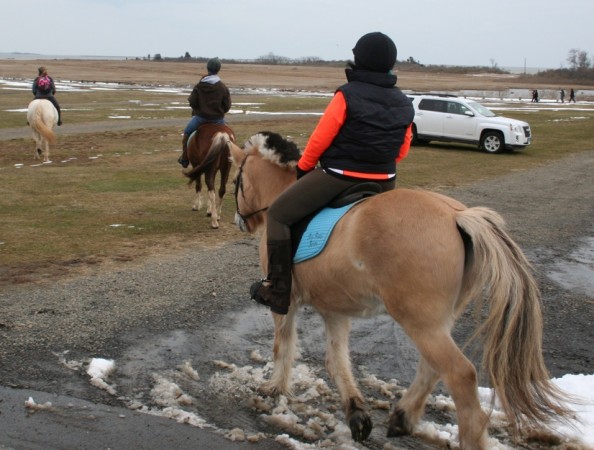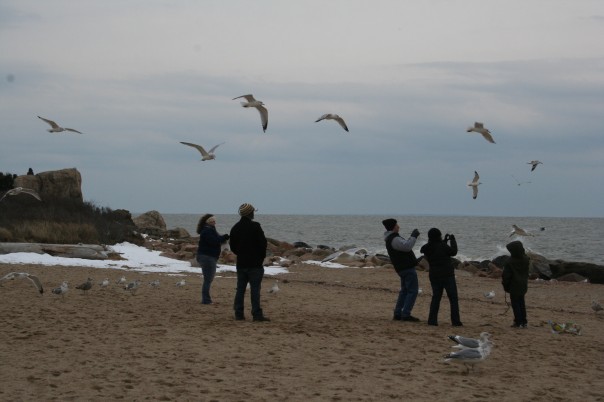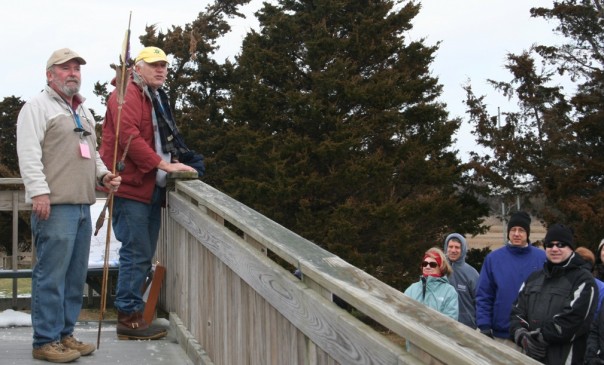Stones And Bones: Stories Told, Why They Matter
 Winter? Hah. Hardy souls seek outdoor activities year round; winter only sharpens their appetite for knowledge and exploration. It's been that way since the dawn of time.
Winter? Hah. Hardy souls seek outdoor activities year round; winter only sharpens their appetite for knowledge and exploration. It's been that way since the dawn of time.
 More than 100 bundled-up walkers turned out for a recent Friends of Hammonasset Beach State Park first day hike led by Don Rankin with Gary Nolf of the World Atlatl Association, on glaciers, human history and shaped stone. The blasting wind outside scoured the near-level coastal landscape. In summer, humans pepper the sandy beach while those intent on fishing find the rocky jetty more to their liking. In a season of less light and much cold, those ranks thin out. Not so for those with a passion for archaeological matters and hidden stories told by the land.
More than 100 bundled-up walkers turned out for a recent Friends of Hammonasset Beach State Park first day hike led by Don Rankin with Gary Nolf of the World Atlatl Association, on glaciers, human history and shaped stone. The blasting wind outside scoured the near-level coastal landscape. In summer, humans pepper the sandy beach while those intent on fishing find the rocky jetty more to their liking. In a season of less light and much cold, those ranks thin out. Not so for those with a passion for archaeological matters and hidden stories told by the land.
For why these things matter, do not miss a recent interview on Your Public Media with Dr. Nicholas Bellantoni, state archaeologist with the Connecticut State Museum of Natural History and Archaeology Center. Inspiring, funny and worth watching – be sure to listen to the one about boys finding a cache of skulls and bones in a quarry pit (the mother didn't believe the tale, so her son ran back and brought her a skull as proof), to another about Bellantoni consulting with Lakota Sioux for an excavation with human remains – and why bones, stones and relics add so much understanding to modern-day life.
Note: Answers to finding artifacts and objects are featured on the CAC site – Dr. Bellantoni will relate the importance to document just where an item was discovered and collect other information that can place a relic in time. (Don't worry, he won't keep your find, just collect facts about it for posterity.)
Note: An opportunity to connect to the past happens on Saturday, Feb. 23, with a guided geology hike and Native American land use walk at 11 a.m., plus an “Archaeology Roadshow” at 3 p.m. where visitors may bring in items to be identified. Free. The nature center is a hub of activities that include a stargazing night, seal watch walk and members are a resource for finding other places to explore in the region. (Some presentations take place indoors at St. Andrews Church, Route 79, in Madison.) Here's the link to the FOH site.
Some highlights about the geological forces that shaped the beach park site: “Connecticut and Long Island Sound were covered with glacial ice at least a mile thick about 21,000 years ago. That ice continually moved south from its origin near Hudson's Bay in Canada. As it moved, the ice picked up loose material on the Earth's surface, from dust to house-sized boulders. . . . By the time the ice moved as far south as Long Island, New York, the temperature was warm enough that the front of the ice melted as fast as the ice advanced. Loose material frozen into the ice was dumped as the ice melted. This created a long east-west ridge of unsorted sediments, called a moraine.

“Till underlies the soil at Meigs Point Nature Center, the picnic area behind the center and probably also under the salt marsh . . . The most obvious sediments are the large boulders along the shore at the east end of the beach at Meigs Point.” – from Geology of State Parks
Did You Know: The Museum of Natural History and Connecticut Archaeology Center are home to the University of Connecticut's Anthropological Collections and represents the single largest repository of Connecticut Native American, colonial and industrial artifacts in existence. The materials document more than 11,000 years of human history. Many of the artifacts are one-of-a-kind.

